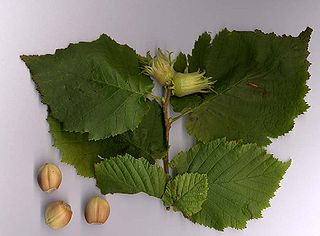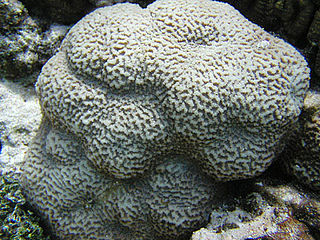
The International Union for Conservation of Nature (IUCN) Red List of Threatened Species, founded in 1964, is the world's most comprehensive inventory of the global conservation status of biological species. It uses a set of precise criteria to evaluate the extinction risk of thousands of species and subspecies. These criteria are relevant to all species and all regions of the world. With its strong scientific base, the IUCN Red List is recognized as the most authoritative guide to the status of biological diversity. A series of Regional Red Lists are produced by countries or organizations, which assess the risk of extinction to species within a political management unit.

Taxus is a genus of coniferous trees or shrubs known as yews in the family Taxaceae. They are relatively slow-growing and can be very long-lived, and reach heights of 2.5–20 metres (8.2–65.6 ft), with trunk girth averaging 5 metres (16 ft). They have reddish bark, lanceolate, flat, dark-green leaves 10–40 millimetres long and 2–3 mm broad, arranged spirally on the stem, but with the leaf bases twisted to align the leaves in two flat rows either side of the stem. The oldest known fossil species are from the Early Cretaceous.

Corylus avellana, the common hazel, is a species of hazel native to Europe and western Asia, from the British Isles south to Iberia, Italy, Greece, Turkey and Cyprus, north to central Scandinavia, and east to the central Ural Mountains, the Caucasus, and northwestern Iran. It is an important component of the hedgerows that were the traditional field boundaries in lowland England. The wood was traditionally grown as coppice, the poles cut being used for wattle-and-daub building and agricultural fencing.

Pinus contorta, with the common names lodgepole pine and shore pine, and also known as twisted pine, and contorta pine, is a common tree in western North America. It is common near the ocean shore and in dry montane forests to the subalpine, but is rare in lowland rain forests. Like all pines, it is an evergreen conifer.

Pinus virginiana, the Virginia pine, scrub pine, Jersey pine, is a medium-sized tree, often found on poorer soils from Long Island in southern New York south through the Appalachian Mountains to western Tennessee and Alabama. The usual size range for this pine is 9–18 m, but can grow larger under optimum conditions. The trunk can be as large as 20 inches diameter. This tree prefers well-drained loam or clay, but will also grow on very poor, sandy soil, where it remains small and stunted. The typical life span is 65 to 90 years.

Jack pine is an eastern North American pine. Its native range in Canada is east of the Rocky Mountains from the Mackenzie River in the Northwest Territories to Cape Breton Island in Nova Scotia, and the north-central and northeast of the United States from Minnesota to Maine, with the southernmost part of the range just into northwest Indiana and northwest Pennsylvania. It is also known as grey pine and scrub pine.

A least-concern species is a species that has been categorized by the International Union for Conservation of Nature (IUCN) as evaluated as not being a focus of species conservation because the specific species is still plentiful in the wild. They do not qualify as threatened, near threatened, or conservation dependent.

A species that is extinct in the wild (EW) is one that has been categorized by the International Union for Conservation of Nature as known only by living members kept in captivity or as a naturalized population outside its historic range due to massive habitat loss.

Cookeconcha is a genus of small air-breathing land snails, terrestrial pulmonate gastropod mollusks in the family Endodontidae.
Taxus fuana is a species of conifer in the yew family, Taxaceae. It is found only in China.

Day's shrew is a species of mammal in the family Soricidae. It is endemic to India. Its natural habitat is subtropical or tropical dry forests. It is threatened by habitat loss.
Letomola contortus is a species of small air-breathing land snails, terrestrial pulmonate gastropod mollusks in the family Charopidae. This species is endemic to Australia.

Shorea contorta is a species of plant in the family Dipterocarpaceae. It is endemic to the Philippines.

The World's 25 Most Endangered Primates is a list of highly endangered primate species selected and published by the International Union for Conservation of Nature (IUCN) Species Survival Commission (SSC) Primate Specialist Group (PSG), the International Primatological Society (IPS), Global Wildlife Conservation (GWC), and Bristol Zoological Society (BZS). The IUCN/SSC PSG worked with Conservation International (CI) to start the list in 2000, but in 2002, during the 19th Congress of the International Primatological Society, primatologists reviewed and debated the list, resulting in the 2002–2004 revision and the endorsement of the IPS. The publication was a joint project between the three conservation organizations until the 2012–2014 list when BZS was added as a publisher. The 2018–2020 list was the first time Conservation International was not among the publishers, replaced instead by GWC. The list has been revised every two years following the biannual Congress of the IPS. Starting with the 2004–2006 report, the title changed to "Primates in Peril: The World's 25 Most Endangered Primates". That same year, the list began to provide information about each species, including their conservation status and the threats they face in the wild. The species text is written in collaboration with experts from the field, with 60 people contributing to the 2006–2008 report and 85 people contributing to the 2008–2010 report. The 2004–2006 and 2006–2008 reports were published in the IUCN/SSC PSG journal Primate Conservation,, since then they have been published as independent publications.

Anthosachne sacandros is a species of true grass in the tribe Triticeae. It is endemic to the Richmond temperate forests of the Marlborough Region, New Zealand. It is a medium-size, tufted, perennial grass that is primarily coastal, but extends inland in some locations. It grows on limestone cliffs, bluffs and river terraces, from elevations of 0–900 m. It flowers from October–February, and fruits from December–May. It is distinguished from the related A. falcis by its erect growth form, long, thin, ribbed and glaucous leaf blades, and the dense hairs at the leaf blade–ligule junction. It is threatened by introduced species such as the common brushtail possum, and plants such as Lycium ferocissimum and Pinus contorta. Its isolated populations are also threatened by fire, floods and erosion.
Taxus contorta commonly known as the west Himalayan yew is a species of tree in the genus Taxus. It lives in temperate forests of Afghanistan Northern India, Tibet and Pakistan. It is commonly traded as timber for house construction and furniture. Taxus fuana is sometimes considered a synonym for T. contorta.

Platygyra contorta is a species of colonial stony coral in the family Merulinidae. It was described by John Veron in 1990. It is found at depths of 2 to 20 metres and its colonies are over 1 metre (3.3 ft) in diameter. It has been identified as a least-concern species.














